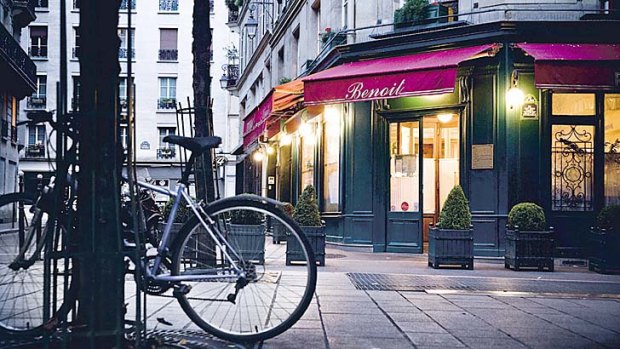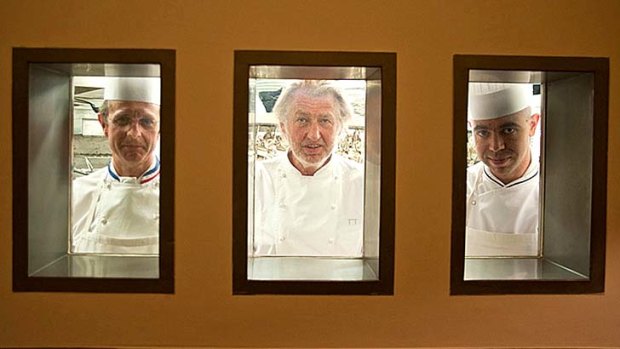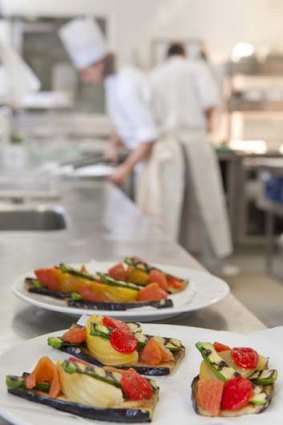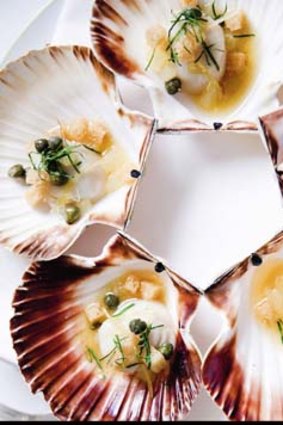
On course... Benoit in Paris is the only bistro with a Michelin star.
Jamie Lafferty follows the famous French guide on a culinary adventure: 700 kilometres, five restaurants, nine Michelin stars.
I'm in Benoit, France's only Michelin-starred bistro, dipping a profiterole into a primordial tar of dark chocolate, when I experience two emotions simultaneously. The first is satisfaction; after such a meal, perhaps I have reached a pinnacle of human existence. The second is pity; this is Paris Fashion Week and on the way to this century-old restaurant in the fourth arrondissment, we passed some models tottering off Paco Rabanne's catwalk. Their careers will never allow them to experience the culinary week we've had - those poor, poor girls.
Using the venerated Michelin Guide, we've driven almost 1000 kilometres through France to some of the nation's finest hotels and restaurants. In more ways than one, it's been a big week.
Five days earlier, my partner, Katy, and I are sitting in Le Pressoir D'Argent, in Bordeaux's aptly named Grand Hotel. While Benoit is a place in which waiters shout, the smell of the soup wafts across the restaurant and strangers sit elbow to elbow, Le Pressoir D'Argent is a much smarter affair - much more Michelin. Yet both have one star in the guide.
To understand why Michelin matters so much, it's important to know that the stars (often pronounced with a tentative hint of French: "Mish-lun") and Michelin tyres (the airs and graces discarded: "Mitch-e-lin") are dispensed by the same company. Founded by brothers Eduoard and Andre, the Michelin tyre empire was a young company when, in 1900, it decided to produce a driving guide to France. The public was still unsure about the future of the automobile - what was wrong with a train, or a horse? The Michelin brothers' logic was simple: encourage people to get on the road, to buy cars and, ultimately, tyres - their tyres.
"This work comes out with the century," Andre wrote in the preface to their first edition. "It will last as long." As the tyre business grew, so did the number of judges employed by the company. Crucially, the money from the tyre business meant Michelin could afford to pay for their inspectors' trips, allowing them to remain anonymous.

Pierre Gagnaire with fellow chefs at his Paris restaurant.
By the 1930s, the guide had expanded to review not just destinations (the Green Guides are still in production) but also individual hotels and restaurants. Thus the Red Guide was born, a not-so-humble little book that would go on to shape the world's fine-dining habits.
It's tempting to compare the announcement of a new edition of the guide in France to the Oscars, except the Oscars are more predictable and a lot less feared. Brad Pitt frequently fails to win Academy awards but becomes richer and more famous. The same does not happen to Michelin-starred chefs. Winning one can add as much as 15 per cent to the revenue of a business, but losing one has at least the opposite effect.
The guide's definitions of its star-rating system are brief and matter-of-fact, verging on the arrogant. The hallowed third star means nothing more than "exceptional cuisine, worth a special journey". It doesn't say that meals will likely cost more than $300 a head. It's just worth getting out of the house for. At this level there are just 105 global members, including Gordon Ramsay, Joel Robuchon and Alain Ducasse.

Le Pressoir D'Argent in Bordeaux.
Two stars - held by London's Le Gavroche and Copenhagen's Noma, among others - signify only "excellent cuisine, worth a detour".
A single star - the kind of thing chefs works their entire lives for - is regarded simply as "an excellent restaurant in its class". It doesn't sound like much, but one star is all they have at Le Pressoir D'Argent in Bordeaux, yet the meal is one of the most unforgettable we have eaten. The starter: two fat scallops and a buttery foie gras swimming in a bowl of chestnut, black truffle and hazelnut froth. The wine pairing is a light bordeaux, which cleanses residual fat from every mouthful, allowing the flavours to dance. The main is a hearty portion of perfectly cooked Atlantic sole with an oyster bearnaise, the chef's speciality. Another wine arrives, fleshing out the taste, adding to the experience. Then the dessert: marinated red pepper served with raspberry ice-cream. Unlikely, but it works. All this and just one star?
I'm not the first to doubt Michelin, of course, nor the first to wonder about its geographical omissions. In Singapore, for example, there are a number of restaurants run by highly decorated chefs. In other countries they have dozens of Michelin stars between them but there are no Michelin-starred restaurants in Singapore because the guide is not published there.

Scallops at Benoit.
Still, in almost all the 23 countries the guide has visited, it has gone on to become the authority on fine dining - everywhere except New York. In an attempt to boost sales, Michelin took the unprecedented step of letting one of its "famously anonymous" judges talk to The New Yorker magazine in 2009. The interview detailed the life of an inspector: the vast amount of food consumed, the eye-watering detail required, the repeated visits by different inspectors at different times.
Michelin's app is available in several languages and this is what we use to navigate from Bordeaux, up the Atlantic coast, through the seaside town of La Rochelle and inland along the Loire River. It's a long drive, with cuisine that changes with the scenery. In La Rochelle and the beautiful neighbouring island of Ile De Re we feast on oysters, the area's speciality. In the Loire, game is popular.
When we sit down for dinner in the two-star Domaine Des Hauts De Loire, we're served rabbit three different ways with tiny vegetables, followed by a chariot de fromage with more than a dozen varieties, including a pungent, red mound called Boulette d'Avesnes (I later discover it's also known as the suppositoire du diable or "the devil's suppository"). The dessert, a rich salted caramel and chocolate mousse, can't come soon enough.
The meal is excellent - it's impossible to find fault - but less spectacular than our experience at the one-star Pressoir D'Argent. We preferred the ambition and showmanship at the Bordeaux restaurant, but this kind of personal preference is precisely the kind of response the guide seeks to avoid by sending more than one judge.
As the anonymous inspector told The New Yorker: "It's not really a 'like' and a 'not like' - it's an analysis ... You're looking at 'Was every single element prepared exactly perfectly, technically correct?' And then you're looking at the creativity. Did it work? Did the balance of ingredients work? Was there good texture? Did everything come together?"'
Those are the questions Pierre Gagnaire has been answering correctly for years. His name is attached to more than a dozen restaurants around the world, but the signature restaurant that carries his name, just off the Champs-Elysees in Paris, is his culinary home and our final stop.
Bibendum, the portly Michelin man, has been smiling in Gagnaire's direction since the restaurant opened in 1996. By 1998 it had three stars. Fourteen years later, the restaurant remains unapologetically elitist and I don't mind admitting to a childish nervousness as we're seated. This isn't helped when I notice some diners are wearing diamonds bigger than the first offerings from the kitchen. The amuse-bouche comprises five mini-selections, each as perfect as a baby's toes: a crab, leek and pomegranate stack; goat's cheese with salmon roe; golden turnip and beetroot; nettle and fennel puree; and haddock on white beans.
The meal progresses through another half-dozen courses, each mind-blowing in its own way. The highlight is a salpicon of scallops in a Jerusalem-artichoke infusion with a hint of mustard alongside a segment of Rubinette apple flavoured with maniguette pepper. It's perhaps the single most satisfying dish I've ever eaten.
Two hours later, we step into the cold air outside, bearing several thousand kilojoules and smiles on our faces. I concentrate on putting one foot in front of the other and reach for my little red book for directions to the next restaurant.
Jamie Lafferty dined courtesy of the restaurants.
FAST FACTS
Getting there
As well as the Red Guide to hotels and restaurants in France, Michelin publishes a large range of maps and regional guides for travelling in France and corresponding apps that include interactive maps. The same information is available free online, see travel.viamichelin.com.
Eating there
The Alain Ducasse-backed Benoit has waiters in bow ties and tabards, and service comes with no small amount of theatre. One Michelin star. Expect to pay €36 ($44.50) for a three-course lunch. At 20 Rue St Martin, 75004, Paris. Closest metro: Chatelet. See benoit-paris.com.
The Grand Hotel and its flagship restaurant, Le Pressoir D'Argent, are in the centre of bustling Bordeaux. The restaurant is actively chasing a second Michelin star, which surely can't be far away. Expect to pay €90 for a four-course dinner and €40 for wine pairing. Grand Hotel, 2-5 Place de la Comedie, 33000, Bordeaux. See ghbordeaux.com.
The twin destinations of Ile De Re and La Rochelle in Poitou-Charentes on the western coast have dozens of eating and sleeping options, but two establishments stand out: on the island, the charming Hotel de Toiras is the only five-star accommodation in the area (hotel-de-toiras.com), and Coutanceau in La Rochelle has two Michelin stars (coutanceaularochelle.com). Expect to pay €55 for a three-course dinner. Plage de la Concurrence 17000, La Rochelle.
In the heart of the Loire Valley, Domaine des Hauts De Loire is a beautiful chateau with a two-star Michelin restaurant of the same name. Expect to pay €77 for a four-course economy taster menu; €160 for the full eight-course option. 79 Rue Gilbert Navard, 41150, Onzain. See domainehautsloire.com.
The master chef's eponymous restaurant, Pierre Gagnaire, remains his finest and most decorated (three stars), located just a few metres from the Champs-Elysees. Expect to pay €105 for lunch and €265 for dinner, wine extra. 6 Rue Balzac, 75008, Paris. Closest metro: George V. See pierre-gagnaire.com.
Sign up for the Traveller Deals newsletter
Get exclusive travel deals delivered straight to your inbox. Sign up now.